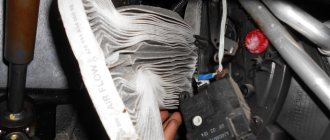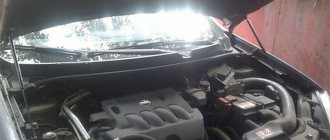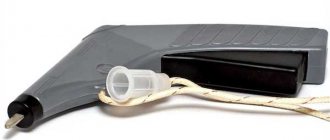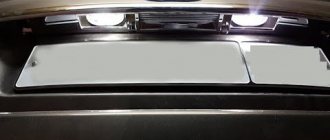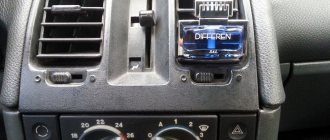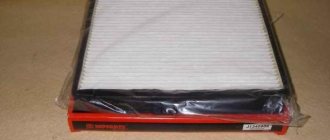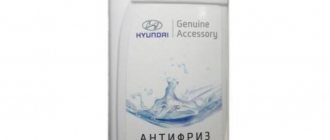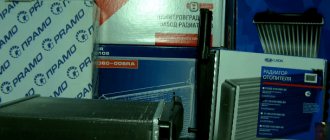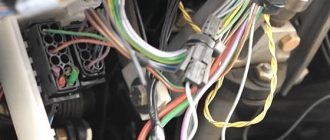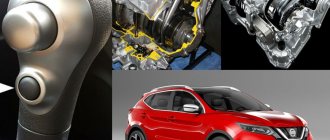Replacing spark plugs is included in the mandatory list of maintenance work for Nissan Qashqai gasoline engines. The quality and stability of the engine and ignition system depends on the condition of the spark plugs. Let's look at how and when to change Nissan Qashqai spark plugs.
Nissan Qashqai J10 with HR16DE engine
Replacement frequency, signs of malfunction
According to the technical documentation for Nissan Qashqai with engine volumes of 1.6 and 2.0 liters, the frequency of replacing spark plugs is identical and amounts to 30 thousand kilometers or 2 years of operation. However, practice shows that original products are capable of working for 40, or even 60 thousand km without any interruptions.
But it is better not to experiment and follow the replacement regulations, which will guarantee uninterrupted operation of the power plant and reduce the likelihood of a breakdown.
Even the most expensive and high-quality spark plugs can fail or begin to work intermittently, and this will immediately be reflected in the engine.
The main signs of poor spark plug condition are:
- Unstable motor operation;
- Difficulty starting;
- The engine is torrid;
- Increased fuel consumption;
- Decrease in dynamic performance.
These signs indicate that the life of the product has been exhausted or that one of them has a defect that affects its performance. Moreover, even if only one spark plug is faulty, everything needs to be changed at the same time.
But do not forget that the signs listed above may also indicate other malfunctions in the car.
Reasons for their natural and premature wear
The spark plug operates under extremely extreme conditions: high temperature in the working cylinder; aggressive environment in the form of a mixture of fuel, air and oil; high pressure during ignition; high voltage and temperature of electric spark. The simultaneous action of these factors leads to an intensification of the processes of their natural wear. This process can be significantly accelerated in the following cases:
- Decrease compression
- Wear of valve stem seals due to oil entering the working volume
- Incorrect setting of the ignition angle, leading to the formation of increased carbon deposits;
- Selecting spark plugs that do not match the engine brand;
- Misfire in cylinders;
- Incorrect gasoline/air ratio due to malfunctions of the flow meter, lambda probe, or air leaks;
- Incorrect operation of injectors.
We carry out diagnostics
Replacing spark plugs allows you to ensure the normal functioning of the power plant, and their inspection provides information about the condition of its main components.
Any disturbances in the operation of the unit manifest themselves in the form of various deposits on the electrodes - soot, deposits, and erosion. Details of what engine problems are indicated by the condition of the spark plugs are shown in the table:
Replacing spark plugs on Nissan Qashqai 1.6 and 2.0 is a truly necessary operation; it not only ensures normal engine operation, but also allows you to identify problems at an early stage and eliminate them, avoiding serious breakdowns and subsequent expensive repairs.
Selecting replacement spark plugs
Nissan Qashqai engines with volumes of 1.6 and 2.0 liters use identical spark plugs - with a heat rating of 6, a threaded part with a length of 26.5 mm and a diameter of 12 mm.
It is recommended to use products with platinum or iridium electrodes, which have a longer service life.
There is also no difference in the products used on engines of different generations, for example, on J10 2.0 liter engines (1st generation) the same spark plugs are used as on J11 2.0 liters (2nd generation).
From the factory, Nissan Qashqai is equipped with spark plugs produced by NGK, which are positioned by the automaker as original and have article number 22401-SK81B. They are sold in Nissan packaging and cost about $10 each.
Also for this car model there are original products with an iridium electrode manufactured by Denso, their article number is 22401-JD01B.
The second option is more preferable for replacement, and this is indicated by the automaker itself, but for some reason it does not install them from the factory. Iridium spark plugs will cost about $15.
One of the problems with original candles in branded packaging is that they are often counterfeited, and they are sold at a slightly inflated price.
NGK has a direct analogue to the original product; it is produced under the symbol NGK5118 (article PLZKAR6A-11). In fact, a candle with article number 22401-SK81B in original packaging and NGK5118 are the same thing, but the latter will cost less - about $7.
The situation is the same with iridium analogues for Nissan Qashqai, designated by article number 22401-JD01B; they have an analogue - Denso FXE20HR11, but in this case the price of the parts is the same.
In addition to these products, you can select analogues from other manufacturers.
Suitable for Nissan Qashqai:
- Bosh with article number 0242135524 (electrode material – platinum, cost – $7.5);
- Beru Z325 (with platinum electrode, price – $6);
- Champion OE207 (electrode – platinum, cost – $8);
- Denso Iridium Tough VFXEH20 (electrodes – iridium-platinum, price – $15).
The indicated cost is an average, but the actual price may differ and depends on the suppliers.
Spark plug selection
To replace Nissan Qashqai spark plugs, you should choose the appropriate option. The original product NGK PLZKAR6A11 will cost from 550 to 600 rubles. Its analogues can be purchased both more expensive and cheaper. For example, spark plugs BOSCH 242135524 and BERUZ325 cost about 400 rubles, and Denso FXE20HR11 - from 900 rubles. Champion OE207 can be found in online stores for 390 rubles.
The main recommendation for those who choose a suitable analogue themselves is not to buy cheap Chinese products. You can save money on such a purchase, but it will last no more than 10-15 thousand kilometers. Because of this, the car owner will have to buy spark plugs more often and replace them.
Tools and equipment for work
The design features of Nissan Qashqai power plants make the operation difficult, but this does not mean that it is impossible to replace the spark plugs yourself.
To get to the necessary elements, you need to remove a number of parts, but this does not require any specific tools, but you will need a torque wrench.
The rest of the tools and equipment are ordinary:
- Wrenches 8-10 (preferably heads with extensions and ratchet);
- Spark plug wrench 14 (with magnet);
- Flat screwdriver;
- Clean rags.
In addition to new spark plugs, it is advisable to purchase gaskets for the intake manifold and throttle assembly to replace them.
Throttle learning
If, when replacing spark plugs, the throttle assembly was not disconnected, but simply moved to the side, then throttle training will not be required. But if the damper has been removed completely, it’s worth picking up a stopwatch and performing the necessary manipulations.
- The internal combustion engine and transmission are warming up.
- All electrical appliances are turned off.
- The gearbox lever is moved to “P”.
- The battery charge is checked - it must be at least 12.9 V.
- The engine stops.
- Pause 10 seconds.
- The ignition is turned on (without starting the power unit and pressing the pedals).
- Pause 3 seconds.
- In 5 seconds, you need to press the gas pedal 5 times and release the gas pedal.
- Pause 7 seconds.
- You need to depress the accelerator pedal all the way and hold it until the word “CHECK ENGINE” appears.
- After the indicated signal appears, the pedal is pressed for another 3 seconds, then released.
- The engine starts. It should idle for at least 20 seconds.
- By pressing the pedal a couple of times (exactly how many times is at the discretion of the owner), sharply gain momentum and, releasing it, reduce it.
If all manipulations are performed correctly and in the correct sequence, the idle speed should be about 700-750 rpm.
Replacement technology
Since replacing Nissan Qashqai 1.6/2.0 spark plugs is a procedure that requires the removal of a number of elements, it would not be superfluous to have photographic equipment to record each stage - this can be of great help during assembly.
Having prepared everything you need, you can start replacing.
IMPORTANT: This operation is performed only on a cold engine.
Let's consider the replacement technology using the example of the Nissan Qashqai 1.6 1.6 l:
- After unscrewing the two mounting bolts, remove the decorative trim of the motor; there is no difficulty here;
- Loosen the clamps and remove the air duct installed between the throttle assembly and the air filter. We also disconnect the crankcase ventilation pipe coming from the cylinder head cover to the air duct;
- We unscrew the bolts securing the throttle assembly and move it to the side (without disconnecting the connectors with wiring and cooling system pipelines from the assembly). The connectors from the throttle valve do not need to be removed or disconnected from the cooling.
Please note that there is a bolt under the throttle assembly that needs to be unscrewed; - We take out the oil dipstick (it is better to cover the hole with something to prevent foreign small elements from getting inside the engine);
- Remove the 7 bolts securing the intake manifold. The 5 front ones should be unscrewed starting from the central one and moving to the sides.
The 6th bolt is located at the left rear of the manifold and secures it through the bracket. The 7th bolt is located on the right, below the mounting hole of the throttle assembly.
Having unscrewed all the fasteners, carefully lift and move the manifold to the side (so as not to disconnect the pipelines from it); - We wipe the manifold mounting holes in the block head and carefully cover them with a rag;
- We wipe the cylinder head cover from dust;
- Disconnect the connectors with wiring from the ignition coils;
- We unscrew the fasteners of the coils and remove them;
- We tear off the candles, but do not unscrew them yet, since we need to blow out the wells with compressed air, wipe them with a clean rag to remove debris;
- We unscrew the candles one by one. If the latter has a magnet installed, removing the elements will not be difficult, since they will be magnetized;
- Using the same wrench, we put the new spark plugs in place and screw them in a little (you can’t just throw them into the well, so as not to disturb the gap between the electrodes);
- They should be tightened using a torque wrench. The tightening force should be 19.6-20 Nm. You cannot tighten it any longer, otherwise you may destroy the partition between the wall of the spark plug well and the cooling system channel (if such a malfunction occurs, the block head must be replaced);
- We put it in place and connect the wiring to the ignition coils;
- Before installing the manifold in place, replace the gasket. The manifold fasteners are also tightened with a torque wrench (force - 27 Nm). First, the inlet part is tightened;
- The same procedure, including replacing the gasket, is performed when installing the throttle assembly, but here the bolts are tightened with a force of 10 Nm.
- Don't forget to connect the vacuum booster hose and put the dipstick in place.
All other parts are installed in place in the reverse order of removal.
Replacing spark plugs on a Nissan Qashqai J11 2.0 is carried out entirely according to the scheme described above, since all gasoline engines of this crossover have the same design, the only difference is in volume.
Spark plug selection
The original spark plugs used by Nissan on these engines are NGK PLZKAR6A-11, not cheap (about 1200 rubles per set) and very specific - long skirt, small hexagon size (14 mm).
Their functional analogues (that is, spark plugs from other manufacturers that have a platinum or iridium coating): Bosch 0242135524, Champion OE207 (platinum), Denso VFXEH22 or FXE20HR11 (iridium). In any case, a set of candles will cost more than 1000 rubles: candles of the same size without platinum or iridium are simply not produced.
Since when replacing you will have to dismantle the throttle and intake manifold, on cars with a decent mileage it is worth buying their gaskets (having hardened over time, they will no longer seal tightly again). For the throttle, the original number is 16175-JG31A, for the intake manifold - 14035-ED800.
